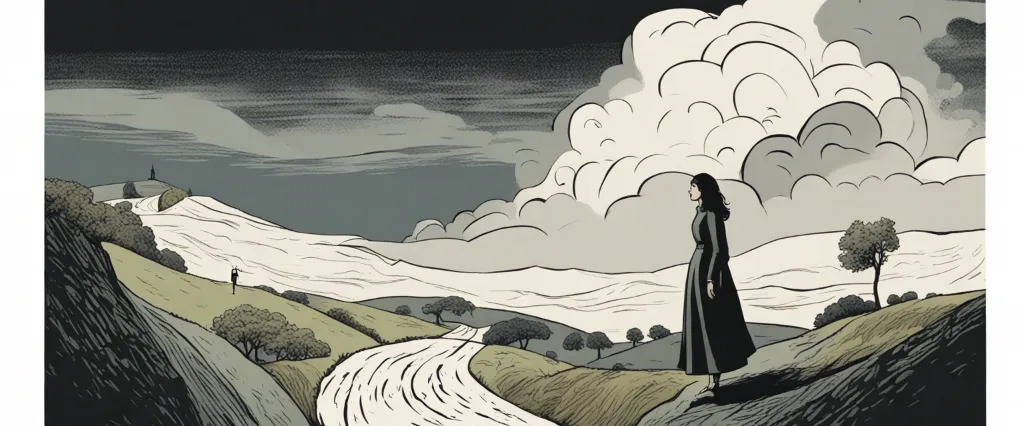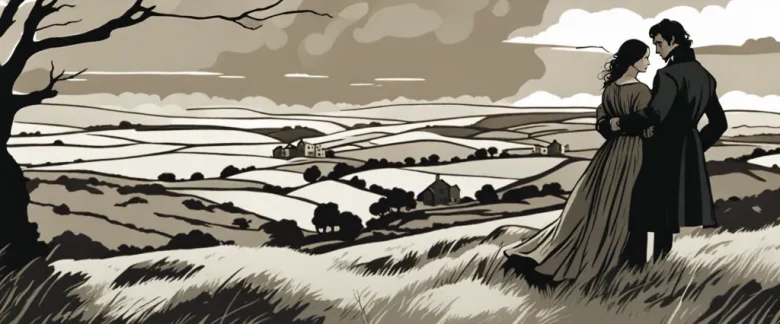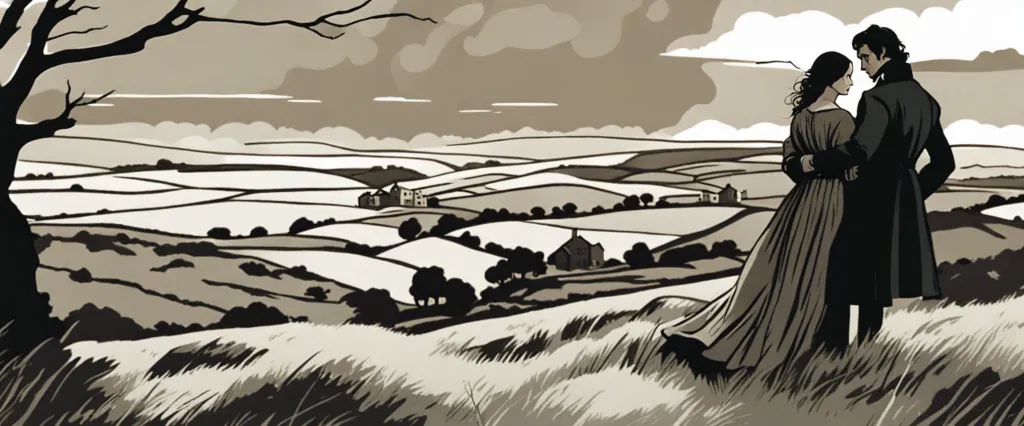Wuthering heights, a captivating and turbulent novel written by Emily Brontë, delves into the lives of two passionate yet tormented soulmates, Heathcliff and Catherine Earnshaw. Set against the dark and mysterious backdrop of the Yorkshire moors in the 18th century, Brontë weaves a haunting tale of love, revenge, and the damnable consequences of unchecked desires. As the second eldest of the infamous Brontë sisters, Emily Brontë is celebrated for her poetic prose and her ability to explore the depths of human emotions. In “Wuthering Heights,” Brontë brings forth a narrative filled with raw intensity and complex characters, leaving an indelible mark on the landscape of English literature.
Introduction to the Earnshaws and the Lintons
In Emily Brontë’s classic novel Wuthering Heights, the story unfolds within the dark and isolated Yorkshire moors, centered around two neighboring families: the Earnshaws and the Lintons. The book primarily focuses on Catherine Earnshaw and Heathcliff, who share a deep and unconventional bond.
The Earnshaws reside in the gloomy Wuthering Heights, an isolated and eerie manor. Mr. Earnshaw, the patriarch, discovers a homeless boy on the streets of Liverpool during a business trip and brings him home to raise as his own. This boy, named Heathcliff, becomes an integral part of the family, yet his mysterious origin and dark features make him an outsider among the Earnshaws. Despite this, young Catherine, Mr. Earnshaw’s daughter, forms an intense attachment to Heathcliff, and they develop a passionate and erratic friendship that blossoms into a deep love.
Meanwhile, neighboring Thrushcross Grange is home to the Linton family. Edgar Linton, the son, represents the complete opposite of Heathcliff. He is a well-mannered, refined, and gentle young man. Catherine becomes acquainted with the Lintons when she is taken in after a serious injury, further developing her fascination with their opulent lifestyle.
As Catherine spends more time in the refined environment of Thrushcross Grange, she grows infatuated with the materialistic benefits it offers. This newfound attraction causes a rift in her relationship with Heathcliff. She is torn between her deep emotional connection with him and the allure of a comfortable life with Edgar, ultimately choosing Edgar’s hand in marriage. This choice sets off a chain of events that will haunt the two families for generations to come.
In this introduction to the Earnshaws and the Lintons, Brontë showcases the stark contrasts between passion and convention, darkness and light, and the destructive consequences of societal expectations in a captivating tale of love, heartbreak, revenge, and haunting tragedy.
Heathcliff’s Arrival and Childhood
Heathcliff’s Arrival and Childhood in Emily Brontë’s novel Wuthering Heights is a crucial part of the story that sets the tone for the intense and tumultuous relationships that follow. The arrival of Heathcliff at Wuthering Heights, a remote farmhouse on the Yorkshire moors, greatly impacts the lives of the Earnshaw family, the inhabitants of the house.
Heathcliff is a mysterious boy found abandoned and brought home by Mr. Earnshaw, the owner of Wuthering Heights. His arrival disrupts the household, as Heathcliff’s dark and brooding nature clashes with the wild and untamed atmosphere of the house. He is initially treated harshly by Hindley, Mr. Earnshaw’s son, who grows jealous of his father’s affections towards the newcomer.
Despite the hostile treatment, Heathcliff forms an intense bond with Catherine, Mr. Earnshaw’s daughter, as they both share an affinity for the untamed nature of the moors. They spend their childhood roaming and playing together, forging a deep connection that borders on obsession. However, as they grow older, their love becomes complicated by societal expectations, leading Catherine to marry Edgar Linton, a wealthy neighbor.
After Mr. Earnshaw’s death, Hindley takes control of Wuthering Heights and subjects Heathcliff to mistreatment. He is degraded to the status of a servant, which fuels his growing resentment and desire for revenge. These early experiences shape Heathcliff’s character, as he becomes hardened and driven by a thirst for power, love, and the destruction of those who have wronged him.
In summary, Heathcliff’s arrival and childhood in Wuthering Heights lays the foundation for the passionate and tumultuous relationships that dominate the rest of the novel. The hardships endured by Heathcliff during his early years shape his character and fuel his thirst for revenge, setting the stage for the dark and haunting story of love, obsession, and revenge that unfolds in Wuthering Heights.
Catherine’s Marriage to Edgar Linton
In Emily Brontë’s novel “Wuthering Heights,” Catherine Earnshaw’s marriage to Edgar Linton plays a significant role in the narrative. Catherine and Edgar’s marriage is characterized by societal expectations, contrasting personalities, and Catherine’s conflicted feelings for her childhood love, Heathcliff.
Catherine’s marriage to Edgar can be seen as a decision based on social status and wealth. Edgar belongs to the Linton family, which is considered to be a part of the upper-class elite, while Catherine comes from the more rough and wild environment of Wuthering Heights. Catherine’s desire for a better position in society influences her decision to marry Edgar, as she believes it will provide her with stability and comfort.
However, the marriage is not founded on deep affection or compatibility. Catherine and Edgar have contrasting personalities and interests. While Edgar is refined, polite, and cautious, Catherine is wild-spirited, passionate, and free-spirited. These differences cause a strain on their relationship, as Catherine struggles to conform to Edgar’s expectations of a proper lady, leading to frequent arguments and misunderstandings.
Moreover, Catherine’s heart remains deeply connected to her childhood companion, Heathcliff. Despite her marriage to Edgar, Catherine cannot deny her intense love and emotional bond with Heathcliff, which existed long before she entered into her union with Edgar. This inner conflict creates tension and turmoil throughout the story, as Catherine is torn between her duty as a wife and her undying love for Heathcliff.
In essence, Catherine’s marriage to Edgar Linton is driven by societal pressures and a desire for a better social position. However, their mismatched personalities and Catherine’s unresolved feelings for Heathcliff lead to a tumultuous and ultimately tragic marriage that is at the heart of the complex and enduring tale of “Wuthering Heights.”
Heathcliff’s Revenge

In Emily Brontë’s novel “Wuthering Heights,” Heathcliff’s revenge plays a central role throughout the story. Heathcliff is introduced as an orphan boy taken in by Mr. Earnshaw, who lives at Wuthering Heights. However, he faces harsh treatment from Hindley, Earnshaw’s son, which fuels his desire for revenge. When Heathcliff falls in love with Catherine, Earnshaw’s daughter, their bond is deep and passionate, but their relationship is cut short when Catherine decides to marry Edgar Linton, a wealthy and refined gentleman.
Heathcliff is devastated by Catherine’s betrayal and is consumed by his thirst for revenge. He leaves Wuthering Heights and, upon his return many years later, it becomes evident that he has amassed a considerable fortune. Heathcliff uses his newfound power to torment those who wronged him in the past, particularly Hindley and his descendants. He manipulates Hindley’s son, Hareton, reducing him to a state of ignorance and servitude.
Additionally, Heathcliff targets Edgar’s family by forcing his son, Linton, to marry his own daughter, Catherine, despite their mutual unhappiness. This unhappy union only worsens Heathcliff’s bitterness and desire for revenge. As the story progresses, it becomes clear that Heathcliff’s revenge is driving him to madness. He is haunted by the memory of Catherine and tormented by his overwhelming desire for retribution.
Ultimately, Heathcliff’s revenge leads to his own destruction. He becomes a tortured and brooding figure, longing for death and for his reunion with Catherine. In the end, his obsessive quest for revenge leaves him alone and defeated, realizing that it has brought him neither satisfaction nor inner peace. The theme of revenge in “Wuthering Heights” serves as a cautionary tale, highlighting the destructive power of vengeance and the price one pays for succumbing to it.
The Love Triangle
Wuthering Heights by Emily Brontë revolves around an intricate love triangle that spans generations. The story begins with the introduction of the Earnshaw family, residing in Wuthering Heights. Mr. Earnshaw brings Heathcliff, a young foundling, into their home, thus sparking a complex web of love and betrayal.
Catherine Earnshaw, the spirited daughter of Mr. Earnshaw, forms a passionate bond with Healthcliff. They share an intense connection, but due to societal expectations and Catherine’s desire for social status, she decides to marry Edgar Linton of Thrushcross Grange, leaving Heathcliff heartbroken. This decision sets in motion a series of tragic events that shape the lives of everyone involved.
Driven by revenge and a tortured love for Catherine, Heathcliff becomes consumed with bitterness. He marries Edgar’s sister, Isabella, to further his scheme. However, his tragic love for Catherine never subsides. Despite their separation, Catherine and Heathcliff’s connection transcends death, as Heathcliff is tormented by her ghost.
Meanwhile, Hareton Earnshaw, the son of Hindley (Catherine’s brother), and young Catherine (Catherine Earnshaw’s daughter) grow up together at Wuthering Heights. A parallel love story emerges between them, mirroring the destructive nature of Catherine and Heathcliff’s relationship.
Ultimately, the love triangle in Wuthering Heights portrays a complex web of unrequited love, betrayal, and revenge. It explores the devastating consequences of societal expectations, as well as the power of love to both heal and destroy. Brontë’s unique narrative style and rich character development make Wuthering Heights a timeless classic that continues to captivate readers.
The Next Generation
The Next Generation of Wuthering Heights is a continuation of Emily Brontë’s classic novel, exploring the lives and destinies of the next generation of characters. Set years after the events of the original book, this sequel delves into the complex lives of the children of Heathcliff and Catherine, as well as other key figures from the first novel.
The story revolves around Hareton Earnshaw, Heathcliff’s son, and Cathy Linton, the daughter of Catherine and Edgar Linton. Both characters have inherited the passionate and turbulent nature of their parents, which affects their lives and the relationships they form. Hareton, despite growing up in a harsh environment, possesses a gentle and compassionate spirit that sets him apart from his vengeful father. Cathy, on the other hand, inherits her mother’s free-spirited nature along with her father’s refinement.
Their paths cross on the moors of Yorkshire, where they form a deep connection and fall in love. However, their relationship is complicated by their shared past and the repercussions of their parents’ tormented history. As they navigate the challenges of their own relationship, they must also confront their family legacies and the lingering presence of Heathcliff.
The Next Generation of Wuthering Heights captures the essence of the original novel, exploring themes of love, revenge, and the destructive power of obsession. It delves into the complexities of family dynamics and the long-lasting impact that past actions can have on future generations. Brontë’s sequel provides a compelling and emotional continuation of the timeless story, posing questions about the potential for redemption and the enduring power of love.
Heathcliff’s Obsession and Decline
Heathcliff’s Obsession and Decline in Emily Brontë’s novel “Wuthering Heights” traces the destructive power of his all-consuming love for Catherine Earnshaw and the subsequent repercussions it has on his life. From the moment Heathcliff sets foot in the Earnshaw household as a mysterious foundling, he forms a deep bond with Catherine. Their shared love is passionate and profound, but for Catherine, it is societal expectations that drive her to reject Heathcliff as a life partner.
This rejection becomes the catalyst for Heathcliff’s descent into obsession. Consumed by an insatiable desire for revenge and a ceaseless longing for Catherine, Heathcliff embarks on a relentless pursuit of power and wealth. He manipulates those around him, especially Catherine’s brother, Hindley Earnshaw, and eventually becomes the master of both Wuthering Heights and Thrushcross Grange. However, his success brings him no joy; all he truly craves is Catherine.
As the years pass, Heathcliff’s obsession only grows stronger, driving him to brutalize those within his reach. He marries Isabella Linton, Catherine’s sister-in-law, only to use her as a tool for revenge against the Linton family. Heathcliff’s cruelty is multifaceted, as he seeks to erase any remnants of the Lintons’ presence while simultaneously tormenting them psychologically.
Ultimately, the all-consuming nature of his obsession with Catherine takes its toll. Heathcliff’s mental and physical deterioration becomes evident, as he loses his grip on reality and frequently hallucinates encounters with Catherine’s ghost. On the night of his death, Heathcliff is found in a state of blissful surrender, finally reunited with Catherine in an afterlife that overpowers the vile hatred and obsessions he held in life.
In “Wuthering Heights,” Heathcliff’s descent into obsession and subsequent decline serves as a cautionary tale about the destructive power of love, revenge, and how they can consume the human soul.

Resolution and Redemption
In Emily Brontë’s classic novel, “Wuthering Heights,” the themes of resolution and redemption are intertwined throughout the story. Set in the harsh and isolated moorlands of Yorkshire, the novel follows the passionate and destructive love story of Catherine Earnshaw, Heathcliff, and their tumultuous relationships with those around them.
Resolution in “Wuthering Heights” comes in the form of Cathy and Hareton Earnshaw, the next generation of characters who embody hope and the possibility of breaking free from the cycle of vengeance and animosity that has plagued their predecessors. Initially, Cathy and Hareton are depicted as immature and uneducated due to the bitterness and cruelty they have grown up amidst. However, as the story progresses, their relationship develops into a genuine and tender love based on mutual understanding and kindness. This serves as a redemption for the mistakes and missteps of their parents’ generation.
Redemption is evidenced in the character arc of Heathcliff, a brooding and vengeful anti-hero who has endured a tragic and abusive childhood. Driven by his obsessive love for Catherine, he becomes consumed by a desire for revenge against those he believes have wronged him. However, towards the end of the novel, Heathcliff experiences a transformation. Haunted by Catherine’s ghost and tormented by his own guilt, he realizes the futility of his rancor and chooses to let go of his desire for revenge. This leads to his ultimate redemption, as he finds solace in death and the prospect of reuniting with Catherine in the afterlife.
In conclusion, “Wuthering Heights” explores the themes of resolution and redemption through the intertwined stories of the next generation and the redemption of the tortured soul of Heathcliff. The resolution is depicted in Cathy and Hareton’s maturation and their potential for breaking free from a legacy of animosity, while redemption is achieved through Heathcliff’s realization of the futility of vengeance and his eventual willingness to let go and find peace. These themes ultimately offer a glimmer of hope and closure in a story otherwise characterized by turmoil and tragedy.
After Reading
In conclusion, Wuthering Heights by Emily Brontë is a haunting and complex novel that explores themes of love, obsession, revenge, and the destructive power of human nature. Set against the backdrop of the wild and desolate Yorkshire moors, the story follows the turbulent relationship between Catherine Earnshaw and Heathcliff, two individuals deeply connected yet constantly at odds with one another. As the narrative unfolds through multiple perspectives and generations, Brontë delves into the dark depths of the human soul, illustrating the lasting consequences of unchecked passion and a desire for revenge. Ultimately, Wuthering Heights serves as a timeless and captivating exploration of the complexities of love and the ways in which it can both elevate and destroy individuals, leaving readers with a profound and unsettling reflection on the depths of human nature.
1. Jane Eyre” by Charlotte Brontë: This classic novel also written by one of the Brontë sisters delves into themes of love, passion, and the struggles of a strong-willed female protagonist. Like “Wuthering Heights,” “Jane Eyre” explores complex relationships and the haunting power of the moors.
2. “Rebecca” by Daphne du Maurier: Similar to “Wuthering Heights,” “Rebecca” is a gothic romance with a dark and mysterious atmosphere. It follows a young woman who marries a wealthy widower and becomes haunted by the memory of his first wife, Rebecca. Themes of love, obsession, and secrets intertwine to create a gripping and atmospheric story.
3. Great Expectations” by Charles Dickens: Although set in a different time period, this Victorian novel shares many similarities with “Wuthering Heights.” Both stories revolve around characters passionately yearning for unattainable love and their struggles to overcome societal obstacles. Dickens’ vivid prose and exploration of class dynamics make this a compelling read.
4. Tess of the d’Urbervilles” by Thomas Hardy: Set in the rugged countryside of England, Thomas Hardy’s tragic novel tells the story of Tess, a young woman who experiences love, betrayal, and the harsh realities of a society that perpetuates her suffering. Like “Wuthering Heights,” this novel explores themes of fate, passion, and the consequences of societal expectations.
5. “The Thorn Birds” by Colleen McCullough: Set in Australia, this epic multigenerational saga is similar to “Wuthering Heights” in terms of its sweeping romance and the exploration of forbidden love. The story follows the lives of a wealthy family and their struggles with love, ambition, and societal expectations. McCullough’s evocative storytelling captures the reader from beginning to end.




